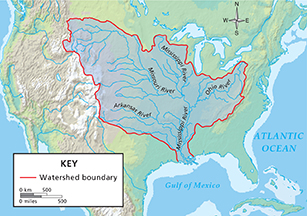Figure 3 The Mississippi River watershed covers most of the central United States. Interpreting Maps Name two tributary rivers that flow into the Mississippi River.

Completing the Cycle
A single molecule of water moves between the surface and atmosphere many times. About 90 percent of the water that evaporates from the oceans falls back into the oceans. Most precipitation that falls on land quickly returns to the atmosphere through evaporation and transpiration. Much of the remaining water seeps into the soil as groundwater or becomes frozen in glaciers. A glacier is a large mass of moving ice and snow on land. Some water that falls on land flows into streams before it returns to the ocean.
Fresh Water
Only a small portion of the water on Earth exists as fresh water. Fresh water is relatively free of minerals and salts.  A small portion of Earth's fresh water is located in the atmosphere, streams, and lakes. Most is located in groundwater and glaciers.
A small portion of Earth's fresh water is located in the atmosphere, streams, and lakes. Most is located in groundwater and glaciers.
The Atmosphere
A tiny percentage of Earth's fresh water is found in the atmosphere in the form of water vapor or clouds. Water enters the atmosphere by evaporation, mostly from the oceans. Water vapor stays in the atmosphere for just a short time—a few hours or a few days—before it falls to the surface as precipitation.
Streams and Rivers
Streams and rivers contain even less fresh water than the atmosphere. However, a great deal of water passes through streams, making them very important in shaping the surface of the land.
When rain falls on land, much of it enters the ground, but some becomes runoff. Runoff is water that flows over Earth's surface. Runoff and some groundwater flows into streams. A stream is any natural channel of flowing water. Streams flow together to form a network, called a river system, that resembles a tree. There is no clear distinction between a large stream and a river. A major river has many smaller streams, called tributaries, that flow into it. Tributaries collect runoff from the surrounding land and channel it into rivers.
The area of land that contributes water to a river system is called a watershed. Watersheds, also called drainage basins, can be small or large. For example, the Mississippi River watershed drains most of the central United States. As you can see in Figure 3, this watershed extends from the Rocky Mountains in the west to the Appalachian Mountains in the east.






